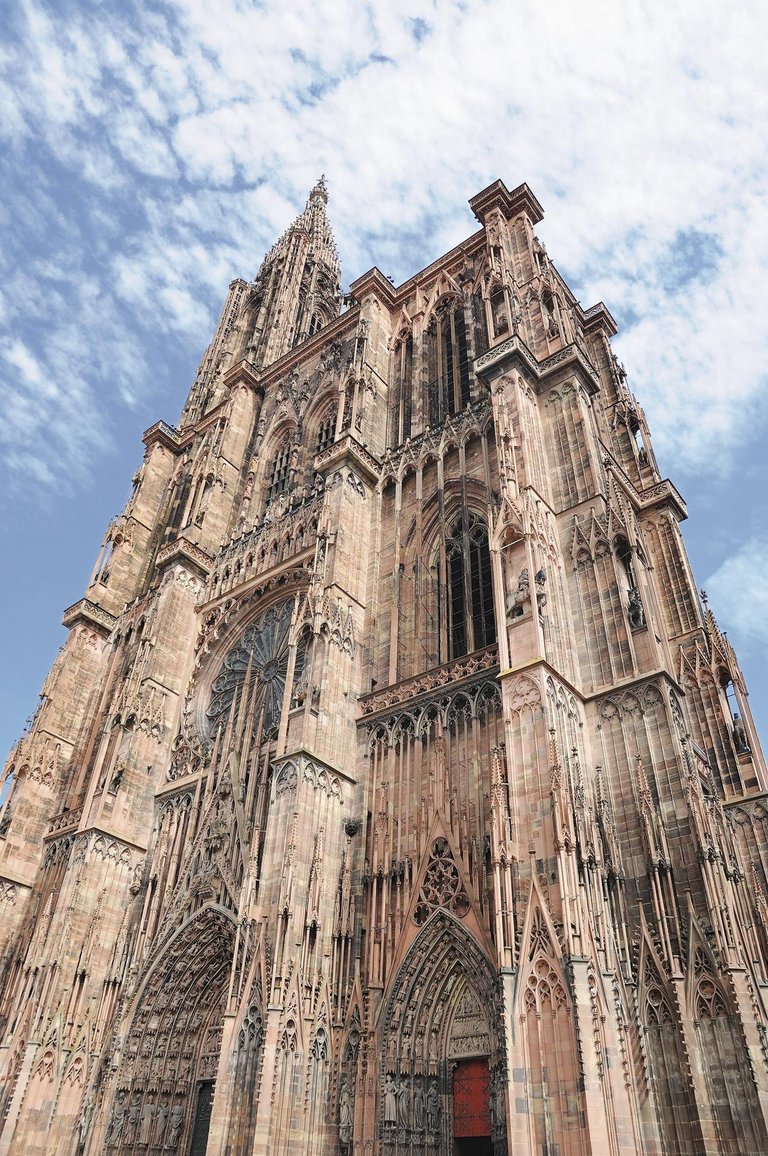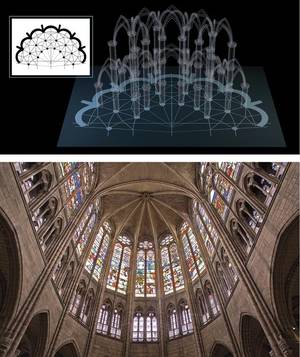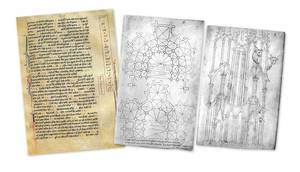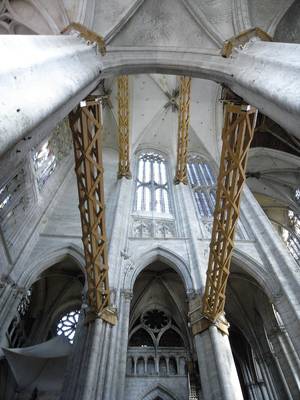Geometric road to the sky

On 19 January 1144 a storm took place in Paris. The waves of wind were very strong and the new arches of the crown of the basilica of Saint Denis were in danger of falling. The reform of the church was being carried out with a new constructive technique and the storm occurred at the worst moment: the arches were finished, the nerves of the church, and the walls between them were not yet built. At that time there were no scaffolds or structures supporting the arches, and not all were still united. The idea of renewing the basilica was that of Abbot Suger, who made a decisive bet. I wanted to build a huge church, and that new construction technique was essential for this.
These works of reform were not finished, but the main nave was that of the previous basilica, so it was not necessary to modify it, so the church itself was in a position to be used and precisely that day of the storm was celebrating Mass for the soul of King Dagoberto. When the strong wind began, they not only prayed for the king, but also for construction.
The arches did not fall. And they fell not by prayer, but by geometry. The nerves were designed with a fine geometric base and made with great precision. The result was a very stable arch and, although the storm knocked down other nearby buildings, the arches of Saint Denis stood still and the next day could begin the reform.
High and luminous
The renewal of the Basilica of Saint Denis is a milestone. It is considered the beginning of Gothic architecture. Suger was looking for a very large and luminous church, for which he needed new techniques and structures, or at least some techniques then had to be adapted, as never before. He began to use the ogival arch to reach the height, and placed on the walls imposing windows and stained glass to create a great luminosity inside the basilica.

This brought some problems. Walls full of windows could not resist the weight of the ceiling vaults. "The problem was solved by geometry and arithmetic," wrote Abbot Suger. The truth is that in that building there was little arithmetic and a lot of geometry. But there were also a lot of engineering, they designed arches that bore the weight and directed the tensions down, added arbotantes and buttresses to support the geometry that sustained the weight, and the Gothic style was born.
Roman numerals
In the Gothic buildings there was not much arithmetic. The master builders lacked the right numbers to perform the calculations: the Arabic numbers. These are the numbers we currently use: 1, 2, 3, etc. Originally they were Indians, but the Europeans learned from the Arabs and therefore receive that name.
XIII. They arrived in Europe at the beginning of the 20th century, with the contribution of the Italian mathematician Leonardo Pisano, known
as Fibonacci. He traveled to Muslim villages to learn mathematics and, when he returned, wrote the book Abaci abaci to spread what he learned with Muslims. It was the year 1202. In the book, for example, he wrote about zero. And about fractions and other properties of numbers. In short, Fibonacci presented Europeans with a systematic and powerful writing of numbers. They were suitable for arithmetic operations, with prices, weights, measures, taxes and any other magnitude.
They were also perfect for architectural calculations, but they did not spread quickly. Only dozens of Gothic cathedrals with Roman numerals started by Europeans before 1202 were built. And almost certainly the XIII. dependents as well. French historian Michel Henry-Claude says that Gothic cathedrals were built "without making real calculations".

Geometry
The construction masters did not make a real calculation, nor did they know trigonometry, and the only way to work with angles was to apply geometry. Very complex geometry, but appropriate.
The plant of the south tower of Chartres cathedral, for example, was designed from a complex octagon pattern. They are many octagons, inscribed to each other. Often the starting point was simpler polygons, squares, triangles and circles, but their combination is very complex. The prestigious expert, the historian Titus Burckhardt, claimed that it is very difficult to guess what these first patterns are through the cathedral itself, but fortunately some design drawings have remained until today. XIII. The best-known is the Livre de Portraiture notebook by the 18th century French architect Villard de Honnencourt, whose drawings perfectly illustrate the geometry used for the renovation of the basilica of Saint Denis.
Burckhardt claims that geometry performs two functions. On the one hand, if applied correctly, that the structures it generates are stable and therefore the cathedrals do not fall. And on the other hand, geometry allowed to build giant cathedrals from a scheme designed in a small scroll. At that time it was impossible to calculate the final dimensions of these small planes. They had no specific means to do so. In the scaling process, precision was completely lost, endangering the fall of the building. On the contrary, being able to draw large polygons, they saved the scaling. "Although they used strings as bars and rules, and if they had a certain degree of flexibility, in general the measurements are accurate, within the error of a few inches"; enough to hold standing a Gothic cathedral.
Accidents

They built true giants that, by medieval standards, came almost to heaven. The 142-metre tall tower of Strasbourg Cathedral was for two hundred years the tallest building in the world. Not only from the outside, but also from the inside, the high temples. The vault of the central nave of the basilica of Saint Denis is 29 metres away; those of the cathedrals of Chartres and Amiens, for example, are 37 and 42 metres high respectively. A medieval person could not find in the world more interior space than a Gothic cathedral.
Cathedrals, besides being large buildings, became symbols of power. It was a demonstration of clergy before civil authorities, which became an indicator of the importance of dioceses. All the bishops wanted to be a cathedral more spectacular than those of neighboring cities. XIII. In the 19th century, in northern France, a competition was launched for the construction of the largest cathedral and the construction masters became stars.
The construction of the cathedrals became a nonsense, competition that took to the limit. The case of Beauvais Cathedral is significant. They wanted to build bigger than Amiens and in 1248 they fell the main vault in the middle of the construction process. They began to work and, in 1573, fell again. The cathedral has remained unfinished and today stands thanks to gigantic steel supports.
Amiens Cathedral itself also has problems. Columbia University experts have analyzed the structure of the building by laser, whose results are not relaxing. The columns of the main nave, for example, should be straight but are tilting; in one direction, in the centre, and in the opposite direction, in the upper part. There are points with a deviation of 20 centimeters. Too much. And computer models show that the cathedral will fall sooner or later, if no measures are taken. Problems begin when they are built and medieval teachers make arrangements. Among other things, they had to forge a huge iron chain to keep the perimeter of the main ship.
Despite the problems, seven or eight centuries later, the results of medieval competition are standing and visible in many European countries. The main tourist attraction of many cities remains the Gothic cathedral.
Buletina
Bidali zure helbide elektronikoa eta jaso asteroko buletina zure sarrera-ontzian











